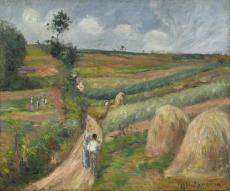


C amille Pissarro was born in 1830 on the island of Saint Thomas in the Antilles, which at the time was a dependent territory of Denmark. His family, of French origin, sent him to study in France and, after a return journey in the Tropics which took him primarily to Venezuela (1847-1849), it was finally in France that the young man, who had decided to become a painter, began his career by showing his work for the first time at the Paris Salon of 1859. Like other young artists with whom he associated from 1870, Pissarro, who claimed to draw his inspiration from Jean-Baptiste-Camille Corot (1796-1875), quickly distanced himself from official artistic currents and, as of 1874, began to exhibit his work with those who came to be known as the Impressionists. From the outset, Pissarro confirmed his preference for landscapes, and his career as an artist is punctuated by the different subjects he tackled, according to his successive places of residence around Paris. In 1870, the Franco-Prussian War forced him, as a Danish national, to seek refuge in London. Shortly after returning to France, he settled in Pontoise, a small town a few kilometres west of Paris, where he had already lived before the war. It was, in fact, landscape scenes of Pontoise and its environs that Pissarro sent to the first Impressionist exhibition in 1874, and then again in 1876, 1877 and 1879, thus linking the artist to the characteristically rugged topography of this old town on the banks of the Oise and the surrounding hillsides.
Richard Brettell, Joachim Pissarro and Claire Durand- Ruel Snollaerts have thoroughly explored the places frequented by the painter and determined that, despite the apparent lack of landmarks, Chemin Montant, Environs de Pontoise, dated 1876, was painted in the vicinity of an old convent known as the Château des Mathurins, in the district of the Hermitage, where Pissarro and his family were living at the time. Besides the old part of Pontoise, the recent development of the town offered the artist a wide variety of subject matter, in which hills and small valleys in quick succession are alternatively occupied by buildings or dedicated to vegetable crops, in the fields and meadows. This particular environment – half-town, half-countryside – allowed Pissarro to define his personal conception of the landscape. His vision is pragmatic, aware of contemporary reality, often concentrated on a certain aspect of a season, of a time of day, of an effect of the light, playing with the framing of the painting and indifferent to the sentimental or historical picturesqueness favoured by academic painters.
Contemporary reviews favourable to Pissarro and sensitive to his unassuming depiction of a familiar countryside bring to mind the example of Jean-François Millet (1814-1875), the painter of L’Angelus (Paris, Musée d’Orsay), whose career had begun long before the emergence of the Impressionists. Nevertheless, Pissarro’s figures clearly dissociate themselves from the heroic grandeur of Millet’s peasants: here, in Chemin Montant, the outlined silhouettes of field workers, both men and women, captured at work, animate an ordinary rustic space by marking out an intriguing composition based on the bizarre geometry of the road, which is turning rather than ‘rising’, cutting through a rugged terrain. A clashing perspective, tipping up the planes, accompanied by a savage reduction of the scale of the figures and the haystacks, often recurs in Pissarro’s paintings of this period. The emphatic method of execution, enlivened by thick brushstrokes, somewhat weighs down this study of a relatively modest format, which could very well be a work begun en plein air, in situ – a common habit of Pissarro and his Impressionist friends – and reworked in the studio. The muted tones represent the sober and grave art created by the painter at the time. In spite of a marked evolution in his style after 1880, to the end of his career Pissarro continued to paint landscapes and peasants, often placing more emphasis on the figures. He remained faithful to his realistic vision of an environment which he knew well, a countryside that had been won over little by little by urban development and the tentacles of the industrial capital. This implicit yet discreetly delivered reflection on the social condition of his contemporaries went hand in hand with the political, socio-anarchist preoccupations to which he adhered very early on and to which he remained loyal, making him one of the few truly militant artists of his generation.
He was sent from Saint Thomas to France to study and there decided to take up painting. He exhibited for the first time at the Paris Salon of 1859 and, as of 1874, began to exhibit with the Impressionists; he was the only one of the group to show at all eight of the Impressionist exhibitions. He remained attached to landscape motifs throughout his career and, always true to his anarchist beliefs, he depicted workers and the effects of urban development as a commentary on contemporary society. Around 1885, he briefly experimented with Neo-Impressionism, and his palette became more vivid. He produced numerous prints, and illustrations for books and for the anarchist press. Six of his eight children, notably Lucien, became artists.